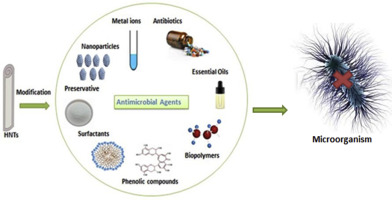当前位置:
X-MOL 学术
›
Adv. Colloid Interface Sci.
›
论文详情
Our official English website, www.x-mol.net, welcomes your
feedback! (Note: you will need to create a separate account there.)
Nano-interfacial decoration of Halloysite Nanotubes for the development of antimicrobial nanocomposites.
Advances in Colloid and Interface Science ( IF 15.9 ) Pub Date : 2019-11-09 , DOI: 10.1016/j.cis.2019.102063 Saeida Saadat 1 , Gaurav Pandey 1 , Maithri Tharmavaram 1 , Vincent Braganza 2 , Deepak Rawtani 1
Advances in Colloid and Interface Science ( IF 15.9 ) Pub Date : 2019-11-09 , DOI: 10.1016/j.cis.2019.102063 Saeida Saadat 1 , Gaurav Pandey 1 , Maithri Tharmavaram 1 , Vincent Braganza 2 , Deepak Rawtani 1
Affiliation

|
In recent times, incorporation of Halloysite Nanotubes (HNTs) with various antimicrobial agents as interfacial materials between these nanotubes and pathogenic microorganisms, for the development of antimicrobial nanocomposites with enhanced antimicrobial activities has gained researcher's interest. The main benefits given by HNT to these nanocomposites include enhanced thermal and mechanical stability of the antimicrobial nanocomposites and also prolong durability and release of the antimicrobial agents in a sustained manner. The exceptional structure of these aluminosilicate minerals based nanotubes (hollow tubular lumen with huge surface area) and oppositely charged surface molecules assist in attaching various molecules on both, the internal surface as well as on the outer surface of these nanotubes. Other advantages of these clay-based minerals are their biocompatibility, non-toxicity, eco-friendly nature and their natural availability with affordable price, which also contribute in selecting them as supporting material for biological applications. Therefore, these clay-based nanotubes have been recently used for developing various antimicrobial nanocomposites. In this review, various antimicrobial nanocomposites developed through incorporation of HNT with myriad antimicrobial agents such as nanoparticles, metal ions, antibiotics, essential oils, biopolymers, phenolic compounds, surfactants and food preservatives as an interface between these nanotubes and microorganisms have been discussed. These antimicrobial nanocomposites could be synthesized in different forms (powder, film, nanocapsule and adhesive) which can be applicable in various fields such as food packaging, water decontamination, waste water management, healing of wounds, antimicrobial agents for surfaces, orthopedics and for the treatment of microbial infections.
中文翻译:

埃洛石纳米管的纳米界面装饰,用于开发抗菌纳米复合材料。
近年来,将埃洛石纳米管(HNT)与各种抗微生物剂结合作为这些纳米管与病原微生物之间的界面材料,以开发具有增强的抗微生物活性的抗微生物纳米复合材料已经引起了研究者的兴趣。HNT给这些纳米复合材料的主要好处包括增强了抗菌纳米复合材料的热稳定性和机械稳定性,并以持久的方式延长了抗菌剂的耐久性和释放。这些基于铝硅酸盐矿物的纳米管(具有大表面积的空心管状内腔)和带相反电荷的表面分子的特殊结构有助于将各种分子附着在这些纳米管的内表面和外表面上。这些基于粘土的矿物的其他优点是它们的生物相容性,无毒,生态友好的性质以及以可承受的价格获得的天然可用性,这也有助于选择它们作为生物应用的支撑材料。因此,这些基于粘土的纳米管近来已用于开发各种抗菌纳米复合材料。在本综述中,已经讨论了通过将HNT与多种抗菌剂(例如纳米颗粒,金属离子,抗生素,精油,生物聚合物,酚类化合物,表面活性剂和食品防腐剂)结合作为纳米管和微生物之间的界面而开发的各种抗菌纳米复合材料。这些抗菌纳米复合材料可以以不同的形式(粉末,薄膜,
更新日期:2019-11-11
中文翻译:

埃洛石纳米管的纳米界面装饰,用于开发抗菌纳米复合材料。
近年来,将埃洛石纳米管(HNT)与各种抗微生物剂结合作为这些纳米管与病原微生物之间的界面材料,以开发具有增强的抗微生物活性的抗微生物纳米复合材料已经引起了研究者的兴趣。HNT给这些纳米复合材料的主要好处包括增强了抗菌纳米复合材料的热稳定性和机械稳定性,并以持久的方式延长了抗菌剂的耐久性和释放。这些基于铝硅酸盐矿物的纳米管(具有大表面积的空心管状内腔)和带相反电荷的表面分子的特殊结构有助于将各种分子附着在这些纳米管的内表面和外表面上。这些基于粘土的矿物的其他优点是它们的生物相容性,无毒,生态友好的性质以及以可承受的价格获得的天然可用性,这也有助于选择它们作为生物应用的支撑材料。因此,这些基于粘土的纳米管近来已用于开发各种抗菌纳米复合材料。在本综述中,已经讨论了通过将HNT与多种抗菌剂(例如纳米颗粒,金属离子,抗生素,精油,生物聚合物,酚类化合物,表面活性剂和食品防腐剂)结合作为纳米管和微生物之间的界面而开发的各种抗菌纳米复合材料。这些抗菌纳米复合材料可以以不同的形式(粉末,薄膜,











































 京公网安备 11010802027423号
京公网安备 11010802027423号